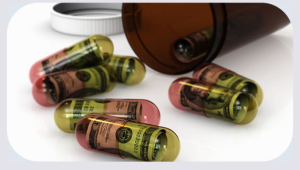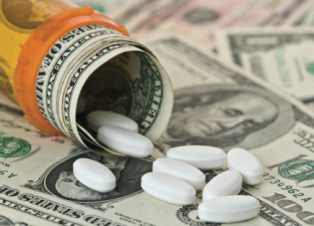 When a new drug is developed, the pharmaceutical company that discovers it receives a patent, usually for about 20 years. This gives the original company time to make back the money that it spent on R&D for the drug.
When a new drug is developed, the pharmaceutical company that discovers it receives a patent, usually for about 20 years. This gives the original company time to make back the money that it spent on R&D for the drug.
If you like, the patent serves as the ‘incentive’ for pharmaceutical companies to take risks and spend lots of money on developing drugs. And remember that the cost of bringing a new drug to the market is over $1 billion – if they were unable to secure profit, how would a pharmaceutical company justify the cost of R&D?
In 2003, economists with ties to the drug industry claimed it cost $802 million to develop a new drug. In 2009, it was estimated at $1.3 to $1.7 billion. And these numbers continue to grow. Some companies spend a lot more – AstraZeneca, for example, spends up to $12 billion in research money for a new drug.
So how can Big Pharma afford to spend so much? For the past several decades, big pharmaceutical companies have relied on the development of blockbuster drugs – that is, drugs that generates more than $1 billion of revenue each year.
“More than half of the revenue of major pharmaceutical companies and above one-third of the total pharmaceutical revenues came from the sales of these blockbuster drugs.” – Debnath et al., 2010
The top leading blockbuster ever developed is Lipitor® (atorvastatin), developed by Pfizer and approved in 1996 for the use of lowering blood cholesterol. Since its approval, sales of Lipitor have exceeded $125 billion, making it the best-selling drug in the history of pharmaceuticals (read more on Lipitor here).
Other top blockbuster drugs include Plavix® (clopidogrel), developed by BMS for atherosclerosis and generating over $9 billion per year and Seretide (fluticasone/salmeterol), developed by GSK for asthma and chronic obstructive pulmonary disease. AstraZeneca holds 3 of the 10 top selling drugs, enabling the company to spend so much on R&D. For a more detailed review, refer to the Top 10 Best Selling Prescription Drugs in the United States, which is a good indicator of overall top-selling drugs.
What happens when a patent runs out?
After the patent expires, a generic version of the drug may become available.
Generic drugs contain the same active ingredients, but can be sold by other companies at a much lower price, as the original company no longer holds the “copyright”, so to speak. Generics are marketed under the drug’s chemical, or “generic,” name and meet the same U.S. Food and Drug Administration (FDA) quality and effectiveness standards as the original.
According to the FDA: “Generic drugs are required to have the same active ingredient, strength, dosage form, and route of administration as the brand name product.”
Generics offer the same safety and effectiveness as the original, but cost much less. This is because they are not required to undergo the costly clinical trials of new drug. Moreover, generics usually do not pay for costly advertising, marketing and promotion, making them much cheaper. Approved generic versions of brand medicines are estimated to bring consumers savings of 30% to as much as 80% (Generic Pharmaceutical Association website).
It wasn’t until passage of the Drug Price Competition and Patent Term Restoration Act of 1984, commonly known as Hatch-Waxman [Public Law 98-417, that the generic industry really flourished. The 1984 United States federal law sets forth the process by which would-be marketers of generic drugs can file Abbreviated New Drug Applications (ANDAs) to seek FDA approval of the generic (wikipedia).
The Hatch-Waxman Act had a significant impact on the U.S. healthcare system – as President Ronald Reagan said at the time, Hatch-Waxman provided “regulatory relief, increased competition, economy on government, and best of all, the American people will save money, and yet receive the best medicine that pharmaceutical science can provide.”- Source: Orrin G. Hatch, in Pharmaceutical Patent Issues
The Hatch-Waxman Act had the dual objectives of incentivizing the development of new brand drugs and facilitating the approval of generics to lower consumer costs. Importantly – this has not had an impact on innovation and drug development.
Indeed, IMS reported last year, that although generic utilization has reached new levels, more new medicines were launched in 2011 than in any other year of the past decade (34 New Molecular Entities, including novel chemical and biologic entities, were launched in the US in 2011, the most in the last 10 years). IMS noted in 2012, “New medicines launched last year brought improved efficacy, safety and convenience for diseases affecting millions of patients battling chronic conditions; important breakthroughs for rare diseases transformed treatment options through personalized medicines based on genetic markers for subtypes of cancer and individually cultured immunotherapies.” (The Use of Medicines in the United States: Review of 2011. IMS Institute for Healthcare Informatics)
Our staggering healthcare costs
The government’s most recent National Health Expenditure Accounts (NHEA) report shows that total U.S. health care spending reached $2.6 trillion in 2010, which translates to $8,402 per person or about 18 percent of the nation’s Gross Domestic Product (GDP) (Report: Generic Drug Savings in the U.S., GPhA). By 2018, according to government projections, national health care spending will reach $4.4 trillion and comprise over one- fifth of the GDP.3
These are pretty terrifying numbers and it is clear that we must find a way to save money. Generic drugs offer a way to do just this, considering that national spending data from 2011 show that the use of generic drugs saved American consumers, taxpayers, federal and state governments and other payers an astounding $1.07 trillion over the decade 2002 through 2011 (Report: Generic Drug Savings in the U.S., GPhA)
Generics reduce healthcare costs
The Food and Drug Administration reports that generics saved U.S. consumers an average of $3 billion a week in 2010, savings that rose to $3.7 billion a week in 2011. National spending data from 2011 show that the use of generic drugs saved American consumers, taxpayers, federal and state governments and other payers an astounding $1.07 trillion over the decade 2002 through 2011.
According to a 1998 study by the Congressional Budget Office, generic drugs save consumers between $8 billion and $10 billion each year. And these figures have risen in the last 15 years. Generic medicines account for 69% of all prescriptions dispensed in the United States, yet only 16% of all dollars spent on prescriptions (source: IMS Health).
About 80% of drugs approved by the FDA have a generic counterpart – It is therefore always useful to check whether a generic version of your drug is available at a lower cost. (For a list of drugs approved by the FDA see here)
Always check for savings – A helpful took is the DrugDigest tool that allows you to see whether a generic version of your prescribed drug is available. Use link here, and click ‘interactive tools’ followed by ‘check for savings’.

Read the GENERIC DRUG SAVINGS IN THE U.S. (FOURTH ANNUAL EDITION: 2012) – see here
According to the American Medical Association (AMA):
“[O]ne of the primary ways physicians can practice cost-effective prescribing is by offering patients a generic medicine when one is available.” (Reference). And according the managing editor of Best Buy Drugs – “Switching to generic whenever possible is, quite simply, one of the clearest paths to reducing health care spending in the years ahead.” (Reference)
The end of branded drugs?
The overall generic utilization rate reached 80 percent in 2011, meaning that more than 3.2 billion of the approximate 4 billion total brand and generic prescriptions written in the U.S. last year were dispensed using generic versions of branded drugs.
The European Parliament decided last Wednesday (6th of February 2013) that patients should have quicker access to cheaper generic medicines. The draft rules will require national authorities to meet new deadlines and transparency standards on pricing and reimbursement.
Rapporteur Antonyia Parvanova from the Alliance of Liberals and Democrats for Europe (ALDE) said – “We need fair, transparent and evidence-based decisions for our healthcare systems in Europe and I hope that all institutions will be willing to engage in this direction. Citizens and patients can count on the European Parliament for maintaining these principles in our future discussions. […] I’m convinced that fair practices in our pharmaceutical market would also benefit patients and national healthcare systems.”
Her report was adopted with 559 votes in favour, meaning the Parliament has ruled for quicker access to generic drugs. She will now negotiate an agreement with EU ministers.
References:
Generic Pharmaceutical Association
